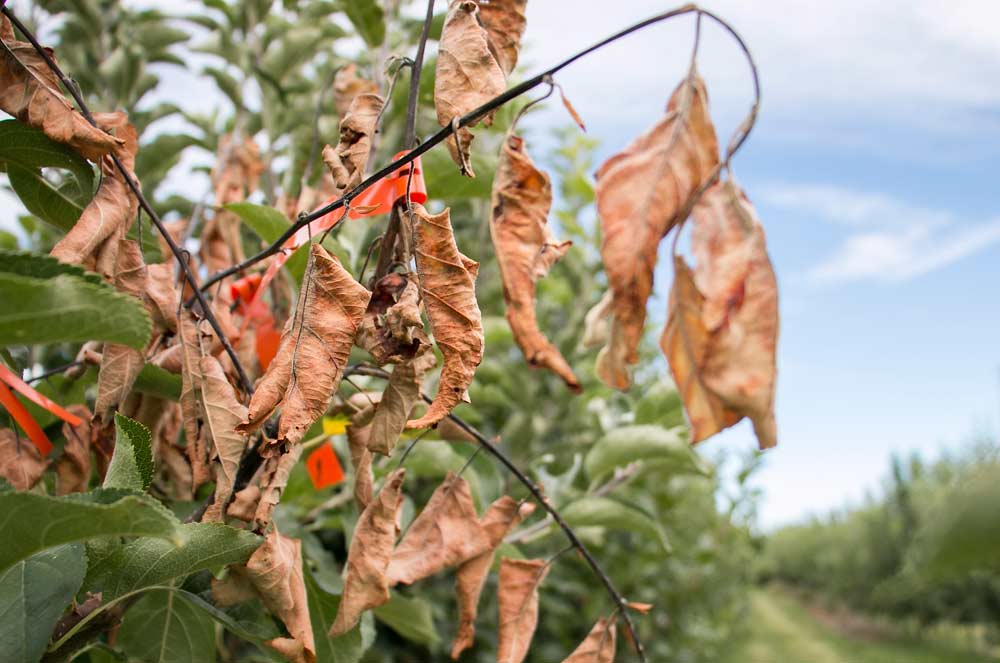
Fireblight symptoms in an otherwise healthy apple tree in August 2017, at the Columbia View research orchard in Wenatchee. The plants were inoculated in the spring for a research study. (Ross Courtney/Good Fruit Grower)
Orchardists in Central Washington should be on high alert for fire blight this year, as high levels of the pathogen that cause the disease likely still linger from last year’s difficult season.
Growers have more tools than ever to fight the fire blight pathogen — the biological products developed for organic growers can boost conventional management as well — but the risks are also increasing, as more growers push young orchards with intensive nutrition programs that put baby trees at higher risk.
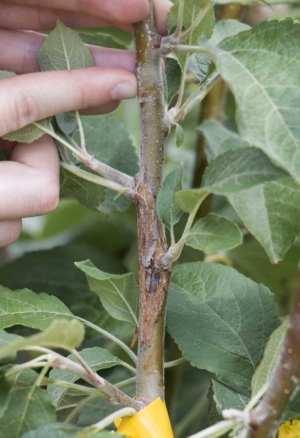
Sarah Kostick, a Washington State University graduate student, points to the spot of inoculation on an apple tree in August 2017, at the Columbia View research orchard in Wenatchee. Notice how the symptoms have moved down the shoot toward the trunk, causing a lesion several inches lower. Even though the shoot is still alive, growers should prune well below that legion or the disease could overwinter, Kostick said. (Ross Courtney/Good Fruit Grower)
“There’s a lot of tools now and some of the tools are better than others, depending on your situation,” said Ken Johnson, plant pathologist at Oregon State University. He offered advice on common problems and best practices at the Washington State Tree Fruit Association Annual Meeting, along with Drew Hubbard of G.S. Long, who offered spray recommendations.
While much of the advice was likely familiar to growers who’ve been paying attention to new prevention products the past few years, Johnson also shared new findings on fighting secondary infection in young trees.
“The thing about cutting blight is that if you cut it once, there’s a chance you did a good job and the blight won’t come back, or it comes back really hard and kills the tree,” Johnson said in an interview. To help the tree turn on its immune system to fight a resurgence, he paints concentrated Actiguard (acibenzolar-S-methyl) on the central leader.
“It’s a chemotherapy for trees,” he said.
Painting a 1-meter stretch on the central leader with Actiguard at 1 ounce per quart along with a silicon surfactant induces resistance in the whole tree, he said. Actiguard is already registered for this use, as well as the typical preventative spray programs growers are likely familiar with.
Secondary infection occurs because pathogen cells moved farther into the tree tissue than the blighted branch that was removed.
“In a lot of cuts, the pathogen has drifted down in the tree below where you see the disease. The pathogen will come back at the cut because you didn’t get it all out,” Johnson said. “You never get it all. The question is, did you get enough so that it doesn’t come back again.”
For a long time, growers saw blight return at the cut and blamed a lack of sanitizing tools or the original wounds. Johnson said that’s just not the case, and he favors skipping sanitizing in favor of speed.

Jose Luis-Serna sprays chlorine disinfectant at the site of a cut he made to remove fire blight strikes from this Bartlett tree in Medford, Oregon, in 2013. While sanitizing both the cuts and the tools used to make the cuts has been a common method used by growers on trees infected with fire blight, more recent research suggests sanitizing is not effective and may be skipped entirely. (TJ Mullinax/Good Fruit Grower)
“We’ve tried to make trees sick by cutting them and painting the fire blight pathogen on them, and it’s really hard to do. I don’t disinfect tools and it’s never made a difference,” he said. “You are better off cutting aggressively and not disinfecting your tools; people move faster through the block without sanitation.”
By aggressive, he means 2 to 4 feet below the canker in young, susceptible trees. In older, slower growing trees, a foot to 18 inches is typically sufficient. For trees 2 years old or less, it’s better to just pull them.
Protecting young and organic trees
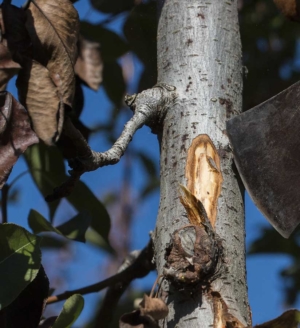
Photo 1: When looking for fire blight and the best location to cut out of pear trees, Jose Luis-Serna uses a hatchet to peel bark away from the tree until he sees healthy green tissue, as seen in Photo 2 below. (TJ Mullinax/Good Fruit Grower)
That’s why protecting those young trees should be a top priority, especially in blocks that are being pushed to fill space fast.
“When you are investing in these fertility programs, you really want to have a good fire blight program, too,” Johnson said at the show. “From the first to third leaf, a weekly program of copper or Actiguard is a good idea through the summer.”
Actiguard stimulates the trees’ immune response, boosting the effectiveness of antibiotics for a longer time, said Drew Hubbard of G.S. Long at the annual meeting.
“Antibiotics get you 80 percent of the way, Actiguard gets you to 90,” he said, adding that nothing on the market gets 100 percent disease suppression. The effectiveness of Blossom Protect (Aureobasidium pullulans) varies widely, but following it with Serenade (Bacillus subtilis) or coppers seems to increase reliability, he said.
For organic growers, fruit safety is a key consideration when selecting products, Hubbard said.
Pear growers in wetter areas should use BlightBan (Pseudomonas fluorescens strain A506) or Bloomtime Biological (Pantoea agglomerans strain E325) instead of Blossom Protect if they are worried about russet risk.
Hubbard recommends a comprehensive program that starts with a fixed copper for sanitation if needed, followed by lime sulfur plus oil for crop load thinning in apples at 20 percent and 70 percent bloom.
It’s important to apply Blossom Protect or BlightBan after lime sulfur, or you’ll need to reapply. These biologicals need good coverage on every row to work and several days to establish before risk peaks.
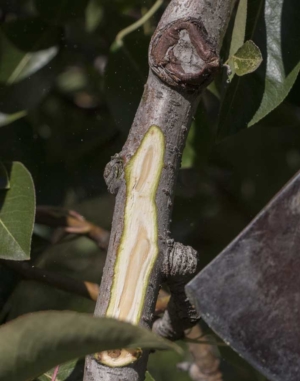
Photo 2
Then, from full bloom to petal fall he recommends Serenade every two to four days, which is the most fruit protective option; Serenade mixed with Cueva for improved control; or for the best control with some russet risk, the soluble coppers, Previso (copper hydroxide) or Cueva (copper octanoate), every three to six days.
In years with extremely high pressure, growers may want to forgo fruit protection in favor of saving their trees with the most effective products, he said.
This integrated approach to fire blight control can also benefit conventional growers, said Tianna DuPont, Washington State University Extension educator. Blossom Protect, the most effective biological product, is very compatible with antibiotics, and it’s not uncommon for apple growers to use both to increase control efficacy if risks are high.
“We know that there is more pressure, and our risk is potentially higher this coming year, so using all the tools you can is a good idea,” she said.
But the most important thing that many Northwest growers aren’t doing is extending their spray program quite long enough to protect their own blocks and neighboring ones, Johnson said. That’s because the pathogen levels peak toward the end of bloom.
“Really, it takes a while to build the population, and then it just builds like crazy at the end. Our data shows that pathogen populations are really increasing into petal fall and after petal fall,” he said.
So, it’s the straggling flowers that pose the most risk to your orchard. Cultivars prone to secondary flowers, such as Bartlett pears and Cripps Pink apples, are more at risk, but any late flower can lead to infection.
Other tips from the talk:
—Remove flowers by hand in baby orchards.
—Switch to drip irrigation during bloom, or turn the water off entirely, because running sprinklers during bloom creates disease-conducive conditions.
—Inspect for blight symptoms on a routine basis for several weeks, since cutting out strikes early gives a greater chance of restoring health.
—Organic growers need to be proactive, not reactive, as the biological control products can’t stop an infection once it’s taken hold like antibiotics can.
—Don’t mix streptomycin and Kasumin, as their modes of action are too similar, but you can mix either with oxytetracycline or Actiguard. “Save the strep hammer for when things get bad,” Hubbard said, and if you don’t need it, skip it.
And in Central Washington, be extra cautious this season. “There’s just no way everybody can clean up what’s out there,” Johnson said. “Just having it in the neighborhood makes a big difference, so growers for sure want to use the lower thresholds in the Cougar Blight model. Any day you feel like you are going to touch 70, you are at risk.” •
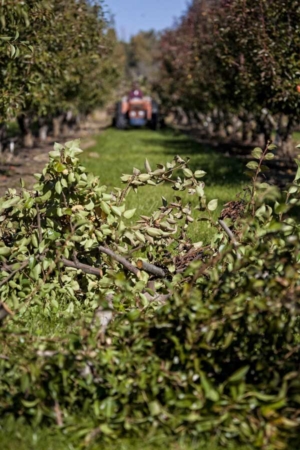
Pear tree prunings that have fire blight in a Medford, Oregon, orchard in October 2013. The branches are piled up by workers before they are removed from the blocks by hand to reduce spreading the infection. (TJ Mullinax/Good Fruit Grower)
Disease diversity
All fire blight is bad news, but all blight is not created equal.
Erwinia amylovora, the bacterial pathogen that causes fire blight, comes in many different strains and some are much more virulent than others, according to Cornell University pathologist Awais Khan.
For years, both growers and breeders have lacked the tools to see these genetic differences.
But today, with gene mapping technology, Khan can study the genetic variation of the pathogen strains and the genetic variation in apple genes that offer resistance or increase susceptibility.
That information will give breeders better tools to select the most resistant genes and layer multiple genes to improve resistance as they select promising new varieties.
Khan, who recently joined Cornell, is setting up an ambitious research program to study fire blight and apple scab with the latest genetic tools.
He also plans to develop a rapid detection tool for the fire blight pathogen, based on DNA markers, that can be used in the field, he told growers at the Cornell Cooperative Extension Lake Ontario Summer Tour last year.
Locally grown biocontrol
Unfortunately for Northeastern apple growers, Blossom Protect and other biological products that allow for organic fire blight control in the West don’t perform consistently under humid conditions.
But the premise behind the biocontrols — allowing a yeast or bacteria to colonize a flower first so that they are ready to out-compete the fire blight pathogen — should work just as well if researchers can find something that’s suited for the Northeastern climate. So, a team of researchers at the Connecticut Agricultural Experiment Station are trying to find just such a perfect microbe — or three.
“Eventually, I would like to create a cocktail with two or three dominant species found on healthy apple flowers that are compatible and manipulate the flower microbiome to reduce disease,” said pathologist Quan Zeng. Such microbes might make antimicrobial compounds or simply out-compete Erwinia amylovora, the fire blight pathogen
But to create such a new biocontrol, he and his colleagues have started at the beginning, by identifying what the microbiome of an apple flower normally looks like in the region and see if any of those natural inhabitants could act as a biocontrol. It’s a more strategic way to find a biocontrol, said Blair Steven, a soil microbiologist who is using genetic tools to identify what microbes thrive on apple flowers.
“The microbiome of the flower is relatively simple and there are distinct sets of bacteria, so the presence of one predicts another,” Steven said. “We’re hoping to take advantage of that, since Erwinia looks like it’s inhibited by the presence of certain microbes.”
Last year, the U.S. Department of Agriculture awarded the three-year research project $459,978. They already found one biocontrol candidate that’s showing strong disease control efficacy in the lab and the field, Zeng said, although it needs further study.
The Connecticut team partnered with colleagues in Massachusetts, Michigan and Wisconsin to study flowers and test promising candidates. Hopefully, it will lead to a better organic disease control options for the growers in rainy, humid regions.
“We have a lot of pick-your-own farms and people who come to the orchard and pick, and for those growers, there’s an additional selling point to have an organically managed orchard so people feel safe,” Zeng said.
—by Kate Prengaman






Leave A Comment